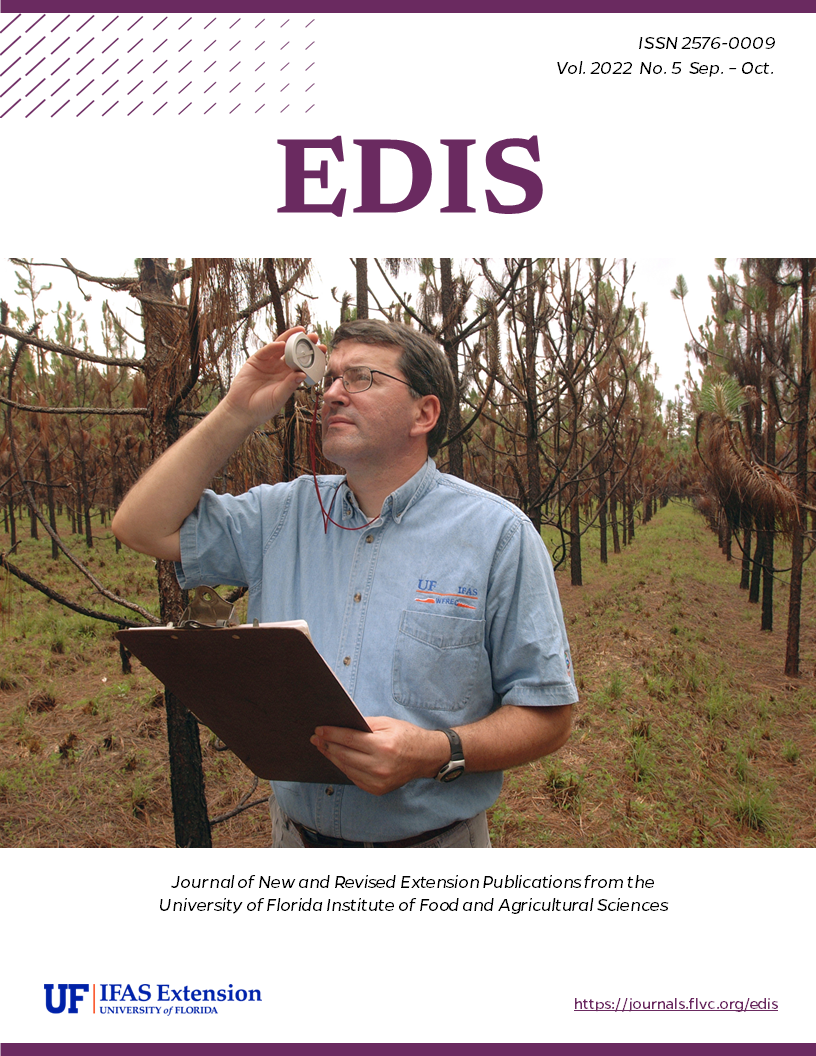Abstract
Toxorhynchites rutilus is one of the largest known species of mosquitoes in North America. Larvae of Toxorhynchites are aquatic predators and prey upon aquatic invertebrates with preference under some circumstances for larvae of other mosquitoes, a characteristic that can contribute to the use of Toxorhynchites mosquitoes as potential biological controls against container-inhabiting mosquitoes (Focks 2007). Larvae of Toxorhynchites can develop in natural containers (e.g., tree holes, plant leaf bases, bamboo, broken stems and internodes) and in artificial man-made containers (e.g., cans, flowerpot saucers, planters, and discarded tires) (Steffan and Evenhuis 1981). Adult females of Toxorhynchites are autogenous and feed only on carbohydrate-rich sources (e.g., nectar, honeydew, and fruit), but not blood which makes them harmless in terms of serving as a vector of pathogens to humans and animals.
References
Alomar AA, Eastmond BH, and Alto BW. 2020. The effects of exposure to pyriproxyfen and predation on Zika virus infection and transmission in Aedes aegypti. PLoS Neglected Tropical Diseases, 14: e0008846. https://doi.org/10.1371/journal.pntd.0008846.
Alomar AA, and Alto BW. 2021. Mosquito responses to lethal and nonlethal effects of predation and an insect growth regulator. Ecosphere, 12: e03452. https://doi.org/10.1002/ecs2.3452.
Alomar AA, and Alto BW. 2022. Evaluation of pyriproxyfen effects on Aedes aegypti and predatory mosquito Toxorhynchites rutilus (Diptera: Culicidae). Journal of Medical Entomology, 59: 585-590. https://doi.org/10.1093/jme/tjab193.
Burkett-Cadena ND. 2013. Mosquitoes of the Southeastern United States. University of Alabama Press, Tuscaloosa, Alabama. 176p.
Bradshaw WE, and Holzapfel CM. 1975. Biology of tree-hole mosquitoes: photoperiodic control of development in northern Toxorhynchites rutilus (Coq.). Canadian Journal of Zoology, 53: 889-893. http://dx.doi.org/10.1139/z75-102.
Bradshaw WE, and Holzapfel CM. 1983. Predator-mediated, non-equilibrium coexistence of tree-hole mosquitoes in southeastern North America. Oecologia, 57: 239-256. http://dx.doi.org/10.1007/BF00379586.
Bradshaw WE, and Holzapfel CM. 1988. Drought and the organization of tree-hole communities. Oecologia, 74: 507-514. http://dx.doi.org/10.1007/BF00380047.
Campos RE, and Lounibos LP. 2000a. Natural prey and digestion times of Toxorhynchites rutilus (Diptera: Culicidae) in southern Florida. Annals of the Entomological Society of America, 93: 1280-1287. http://dx.doi.org/10.1603/0013-8746(2000)093%5B1280:NPADTO%5D2.0.CO;2.
Campos RE, and Lounibos LP. 2000b. Life tables of Toxorhynchites rutilus in nature in southern Florida. Journal of Medical Entomology, 37: 385-392. https://doi.org/10.1093/jmedent/37.3.385
Collins LE, and Blackwell A. 2000. The biology of Toxorhynchites mosquitoes and their potential as biocontrol agents. Biocontrol News and Information, 21: 105N-116N.
Focks DA, Hall DW, and Seawright JA. 1977. Laboratory colonization and biological observations of Toxorhynchites rutilus rutilus. Mosquito News, 37: 751-55.
Focks DA, and Boston MD. 1979. A quantified mass-rearing technique for Toxorhynchites rutilus rutilus (Coquillett). Mosquito News, 39:61 6-19.
Focks DA, Sackett SR, Dame DA , and Bailey DL. 1983. Toxorhynchites rutilus rutilus (Diptera: Culicidae). Field studies on dispersal and oviposition in the context of the biocontrol of urban container breeding mosquitoes. Journal of Medical Entomology, 20: 383-390. http://dx.doi.org/10.1093/jmedent/20.4.383.
Focks DA, and Sackett SR. 1985. Some factors affecting interactions of Toxorhynchites amboinensis with Aedes and Culex in an urban environment. Pp. 55-64 in LP Lounibos, JR Rey and JH Frank (eds.) Ecology of Mosquitoes. Proceedings of a Workshop. Florida Entomology Laboratory, University of Florida, Vero Beach.
Focks DA. 2007. Toxorhynchites as biocontrol agents. Journal of the American Mosquito Control Association, 23(sp2): 118-127. http://dx.doi.org/10.2987/8756-971X(2007)23%5B118:TABA%5D2.0.CO;2
Lounibos LP. 1979. Temporal and spatial distribution, growth and predatory behaviour of Toxorhynchites brevipalpis (Diptera: Culicidae) on the Kenya coast. The Journal of Animal Ecology, 213-236. https://doi.org/10.2307/4110.
Linley JR. 1987. Aerial oviposition flight of Toxorhynchites amboinensis (Diptera: Culicidae). Journal of Medical Entomology, 20: 383-390. http://dx.doi.org/10.1093/jmedent/24.6.637.
Linley JR. 1989. Scanning electron microscopy of the eggs of Toxorhynchites rutilus rutilus and Tx. amboinensis. Journal of Medical Entomology, 26:1-9. https://doi.org/10.1093/jmedent/26.1.1
Lounibos LP, Escher RL, Nishimura N, and Juliano SA.1997. Long-term dynamics of a predator used for biological control and decoupling from mosquito prey in a subtropical treehole ecosystem. Oecologia 111: 189-200. http://dx.doi.org/10.1007/s004420050225.
Lounibos LP, Martin EA, Duzak D, and Escher RL.1998. Daylength and temperature control of predation, body size, and rate of increase in Toxorhynchites rutilus (Diptera: Culicidae). Annals of the Entomological Society of America, 91: 308-314. http://dx.doi.org/10.1007/s004420050225.
Sato S. 1961. Structure and development of the compound eye of Megarhinus towadensis Matsumura (morphological studies on the compound eye of the mosquito, no. VIII). Science Reports Tohoku University, Ser. IV. 27: 7-18.
Steffan WA, and Evenhuis NL. 1981. Biology of Toxorhynchites. Annual review of entomology, 26: 159-181. https://doi.org/10.1146/annurev.en.26.010181.001111.
Schreiber ET. 2007. Toxorhynchites. Journal of the American Mosquito Control Association, 23(sp2): 129-132. https://doi.org/10.2987/8756-971X(2007)23[129:T]2.0.CO;2.
Trimble RM and Smith SM. 1979. Geographic variation in the effects of temperature and photoperiod on dormancy induction, development time, and predation in the tree-hole mosquito Toxorhynchites rutilus septentrionalis (Diptera: Culicidae). Canadian Journal of Zoology, 57: 1612-1618. https://doi.org/10.1139/z79-211
Wilkerson RC, Linton YM, and Strickman D. 2021. Mosquitoes of the World (Vol. 1). Johns Hopkins University Press, 290-291pp.

